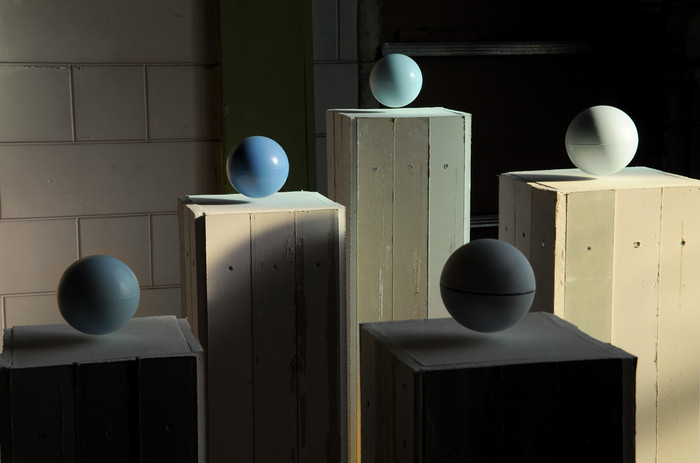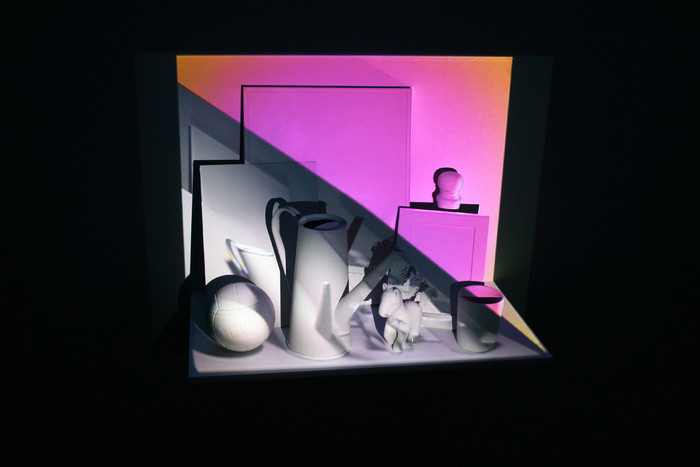The Inner Life of Things (Das Wesen im Ding)
05 Feb - 25 Apr 2010

NINA CANELL
„Temporary Encampment (Five Blue Solids)“, 2009
(Detail)
Electromagnetic devices, gypsum panels, plastic
Photo: Canell & Watkins
Courtesy the artist and Konrad Fischer Galerie
„Temporary Encampment (Five Blue Solids)“, 2009
(Detail)
Electromagnetic devices, gypsum panels, plastic
Photo: Canell & Watkins
Courtesy the artist and Konrad Fischer Galerie

EGILL SAEBJÖRNSSON
„Grey Still Life II”, 2009
Installationview: Grusenmeyer Art Gallery, Ghent
Photo: © Grusenmeyer Art Gallery, Ghent
Courtesy the artist, i8 Gallery Reykjavik and Grusenmeyer Art Gallery Deurle
„Grey Still Life II”, 2009
Installationview: Grusenmeyer Art Gallery, Ghent
Photo: © Grusenmeyer Art Gallery, Ghent
Courtesy the artist, i8 Gallery Reykjavik and Grusenmeyer Art Gallery Deurle
The probing of nature and the world of things through representation and
imitation in order to gain a deeper understanding of the worlds being, runs
like a thread throughout the history of fine art. The central theme in the group exhibition “The Inner Life of Things” revolves around questions of mimesis, which is understood as the simulated representation of reality, and traces the role it takes today in artistic production.
The works at the Frankfurter Kunstverein by the artists Nina Canell,
Florian Haas, Till Krause, Bettina Lauck, Yoon Jean Lee, Egill Sæbjörnsson and Andreas Wegner present different methods in the search for the “Inner Life of Things”. They thereby employ a formal, at first seemingly similar,
language in which they mostly show series of painted, photographic or filmed effigies of everyday objects such as bottles, glasses, balls, stones, mushrooms, flowers, tools, toys or everyday products. By means of various observational and representational approaches, they carry out investigations so as to gain a better insight into the character of the object. In this manner, they also bring something fundamentally new into existence. Thus the artistic works question, in exemplarily fashion, the structure of the “real world” and the relationship of the viewer to it. Complementing the seven artistic positions, several objects from the Museum der Dinge / Werkbundarchiv (Berlin) will be shown.
The concept of mimesis lost its relevance by the beginning of the 20th century with the onset of modernity and prevailing mass media reproductive technolo-gies. Since then, it is exactly this questioning that has become the central motif of artistic production: A representation of what is considered to be the real world is hardly possible without a reflexion on the parameters associated with it. Now, with the most diverse artistic strategies such as seriality, fragmenta-tion, scaling or dissolution, images continue to come into being that put their relationship with reality or their own status into question.
Till Krause (*1965) is known for his mappings of landscapes and spaces. Yet some of his artistic investigations do not refer to actual constellations, as is so in the work “Element für eine künstliche Natur”. This work consists of 128
photographs that each show the same stone before a neutral background, and in which only the viewing angle varies.
After a while it becomes possible to discern that this stone cannot in fact be real and that it concerns, instead, an artificial model. It is an object, which is reminiscent of a “stone”, the mimetic effigy of an idea that was examined with photographic meticulousness.
On the other hand, the artist Florian Haas (*1961) presents in his naive pain-tings that are rich in colour, physical things that arise from his imagination. Therefore, portraits of mushrooms, flowers or physical and scenery pictures appear through a process of sensitive observation and appreciation. Then again, one is reminded of baroque models of naturalistic still life painting in the staged photography of Bettina Lauck (*1973). With dreamlike illuminated fruits, branches and blossoms, the artist leaves the likelihood open, whether they concern arrangements or natural found assemblages.
The works of the Icelandic artist Egill Sæbjörnsson (*1973) and the South
Korean artist Yoon Jean Lee (*1972) focus on little noticed, everyday items such as bottles, cups, tables or chairs. Sæbjörnsson rouses arrangements of still lifes of mundane objects through the use of light, sound installations and video installations; elicits them as protagonists of his stage-like settings in the large hall of the Frankfurter Kunstverein, calling forth new traits as a result. Yoon Jean Lee, again, uses photography of supposedly trivial interior situations to question the attention that everyday objects currently receive, by way of indi-vidual visual compositions and perspectives.
The installations of the Swedish artist Nina Canell (*1979) often appear as functional interconnections: plastic tubs, neon tubes, measuring instruments, loudspeakers, fixtures and documents are combined with natural materials such as branches, stones and earth, as arrangements. These irritate, on the one hand, by means of their unusual sculptural qualities while, on the other hand,
a logic of experimental circulation appears to be the outcome. The being in the thing here turns out to be an interplay between various dimensions.
The contribution to the exhibition by Andreas Wegner (*1958) is to be con-ceived in the context of the store display, which was installed by the artist
during the past exhibition “Notions of the Artists”. This store was a branch
of the currently closed store “Le Grand Magasin” at HermannQuartier, in
Berlin. Within the scope of “The Inner Life of Things” the new installed
objects from cooperative production, which will now no longer be on sale,
pass through redefinition and will now be questioned concerning their
“Dinghaftigkeit” (a kind of “thingliness”).
An extensive program of lectures, events and artist talks accompanies the
exhibition.
“The Inner Life of Things” is made possible by the kind support of Culture Ire-land und the Center for Icelandic Art.
imitation in order to gain a deeper understanding of the worlds being, runs
like a thread throughout the history of fine art. The central theme in the group exhibition “The Inner Life of Things” revolves around questions of mimesis, which is understood as the simulated representation of reality, and traces the role it takes today in artistic production.
The works at the Frankfurter Kunstverein by the artists Nina Canell,
Florian Haas, Till Krause, Bettina Lauck, Yoon Jean Lee, Egill Sæbjörnsson and Andreas Wegner present different methods in the search for the “Inner Life of Things”. They thereby employ a formal, at first seemingly similar,
language in which they mostly show series of painted, photographic or filmed effigies of everyday objects such as bottles, glasses, balls, stones, mushrooms, flowers, tools, toys or everyday products. By means of various observational and representational approaches, they carry out investigations so as to gain a better insight into the character of the object. In this manner, they also bring something fundamentally new into existence. Thus the artistic works question, in exemplarily fashion, the structure of the “real world” and the relationship of the viewer to it. Complementing the seven artistic positions, several objects from the Museum der Dinge / Werkbundarchiv (Berlin) will be shown.
The concept of mimesis lost its relevance by the beginning of the 20th century with the onset of modernity and prevailing mass media reproductive technolo-gies. Since then, it is exactly this questioning that has become the central motif of artistic production: A representation of what is considered to be the real world is hardly possible without a reflexion on the parameters associated with it. Now, with the most diverse artistic strategies such as seriality, fragmenta-tion, scaling or dissolution, images continue to come into being that put their relationship with reality or their own status into question.
Till Krause (*1965) is known for his mappings of landscapes and spaces. Yet some of his artistic investigations do not refer to actual constellations, as is so in the work “Element für eine künstliche Natur”. This work consists of 128
photographs that each show the same stone before a neutral background, and in which only the viewing angle varies.
After a while it becomes possible to discern that this stone cannot in fact be real and that it concerns, instead, an artificial model. It is an object, which is reminiscent of a “stone”, the mimetic effigy of an idea that was examined with photographic meticulousness.
On the other hand, the artist Florian Haas (*1961) presents in his naive pain-tings that are rich in colour, physical things that arise from his imagination. Therefore, portraits of mushrooms, flowers or physical and scenery pictures appear through a process of sensitive observation and appreciation. Then again, one is reminded of baroque models of naturalistic still life painting in the staged photography of Bettina Lauck (*1973). With dreamlike illuminated fruits, branches and blossoms, the artist leaves the likelihood open, whether they concern arrangements or natural found assemblages.
The works of the Icelandic artist Egill Sæbjörnsson (*1973) and the South
Korean artist Yoon Jean Lee (*1972) focus on little noticed, everyday items such as bottles, cups, tables or chairs. Sæbjörnsson rouses arrangements of still lifes of mundane objects through the use of light, sound installations and video installations; elicits them as protagonists of his stage-like settings in the large hall of the Frankfurter Kunstverein, calling forth new traits as a result. Yoon Jean Lee, again, uses photography of supposedly trivial interior situations to question the attention that everyday objects currently receive, by way of indi-vidual visual compositions and perspectives.
The installations of the Swedish artist Nina Canell (*1979) often appear as functional interconnections: plastic tubs, neon tubes, measuring instruments, loudspeakers, fixtures and documents are combined with natural materials such as branches, stones and earth, as arrangements. These irritate, on the one hand, by means of their unusual sculptural qualities while, on the other hand,
a logic of experimental circulation appears to be the outcome. The being in the thing here turns out to be an interplay between various dimensions.
The contribution to the exhibition by Andreas Wegner (*1958) is to be con-ceived in the context of the store display, which was installed by the artist
during the past exhibition “Notions of the Artists”. This store was a branch
of the currently closed store “Le Grand Magasin” at HermannQuartier, in
Berlin. Within the scope of “The Inner Life of Things” the new installed
objects from cooperative production, which will now no longer be on sale,
pass through redefinition and will now be questioned concerning their
“Dinghaftigkeit” (a kind of “thingliness”).
An extensive program of lectures, events and artist talks accompanies the
exhibition.
“The Inner Life of Things” is made possible by the kind support of Culture Ire-land und the Center for Icelandic Art.

